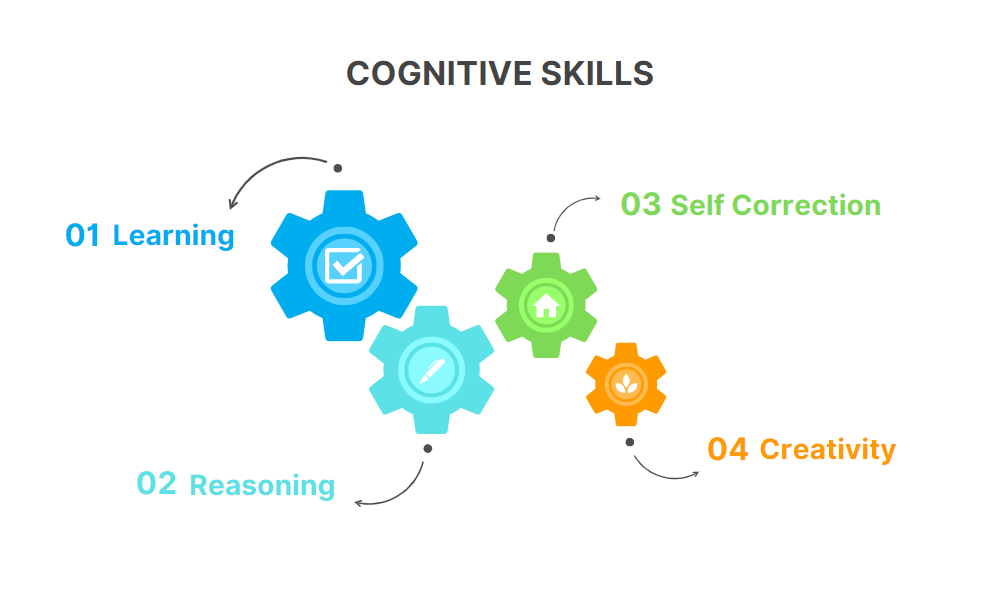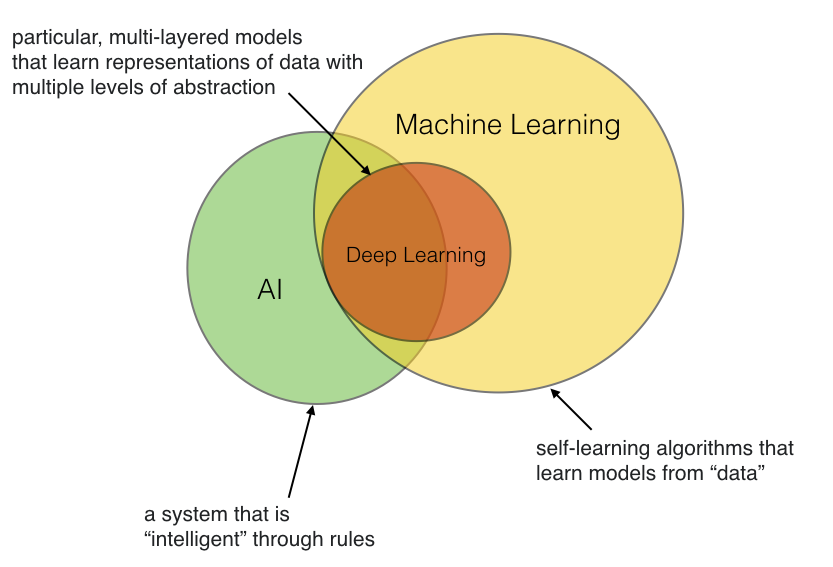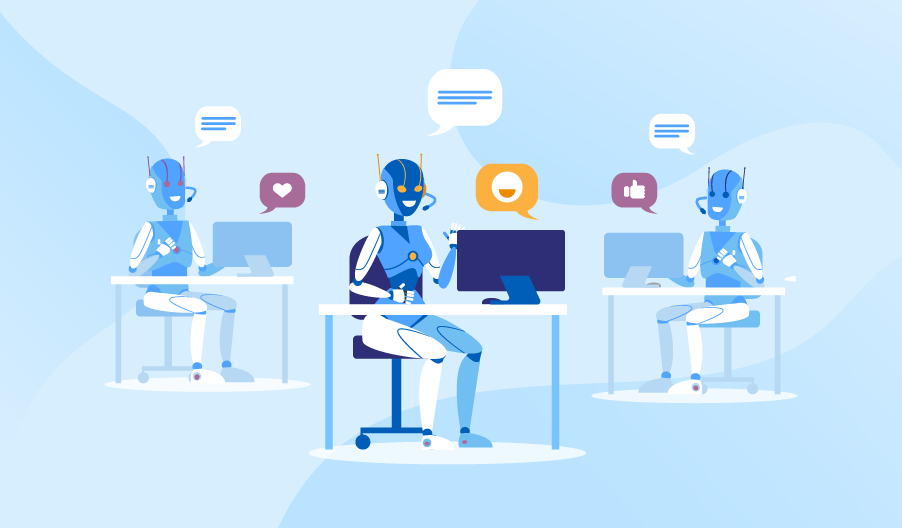ACCELERATED SOLUTIONS
Artificial intelligence (AI) is the model of human insights processes by machines, mainly computer frameworks. A few applications of AI are expert systems language processing and speech recognition, and machine vision.

Figure 1
How does AI work?In common, AI frameworks work by ingesting huge sums of labeled training information, analyzing the data for relationships and patterns, and using these patterns to make predictions about future states. In this way, a chatbot that is fed examples of content can learn to produce similar exchanges with people, or an image recognition tool can learn to spot and describe objects in pictures by looking into millions of examples. Nowadays, modern AIstrategies can make realistic text, images, music, and other media.
AI programming focuses on cognitive skills that include the following:

Figure 2
- Learning.This view of AI programming focuses on gathering information and forming rules for how to turn it into actionable information. The rules, which are called algorithms, offer computing gadgets with step-by-step commands for how to complete a particular task.
- Reasoning.This aspect of AI programming focuses on choosing the correct algorithm to reach a preferred outcome.
- Self-correction.This aspect of AI programming is created to continually fine-tune algorithms and see that they offer the most specific results possible.
- Creativity.This aspect of AIuses neural networks, rules-based systems, statistical methods, and other AI methods to form new images, text, music, and ideas.
AI and Next Generation:

Figure 3
It is understood that the next generation of networks will be able to sense, compute, study, reason, and even act on business intent almost autonomously and manage the ongoing explosion of data from an ever-increasing number of connected intelligent devices. Artificial intelligence plays a major role in enabling automation, managing complications and scalability, and leveraging data from distributed systems in real-time. Progress in this field is breathtaking and relentless.
AI AND MACHINE LEARNING

Figure 4
Machine Learning is considered a subfield or a part of AI, which was concerned with the development of algorithms so that computers can mechanically learn predictive models from data.
Lets say we want to create a program that can make out handwritten digits from images. One would be to look at all of these images and come up with a set of if-this-than-that. On the other hand, we can make use of a machine learning algorithm that can fit a predictive model which is based on thousands of labeled image samples which we may have gathered in a database. Now, there’s also deep learning, which is considered a subfield of machine learning, referring to a particular part of models that are particularly good at some tasks like image recognition and natural language processing.
In short, machine learning and deep learning help to build up AI on the other hand, AI doesn’t essentially have to be created using machine learning, although, machine learning makes AI much more suitable.
AI FOR INFORMATION TECHNOLOGY (IT) OPERATIONS (AIOps)

Figure 6
The name AIOps refers to the method of using artificial intelligence (AI) to mechanize and enhance IT operations.Artificial intelligence for IT operations (AIOps) gathers complicated methods from deep learning, data streaming processing, and domain knowledge to analyze infrastructure records from internal and external sources to automate operations and identify unusual system behavior before they impact the quality of service.
Earlier, IT operations used to be uncomplicated. Some IT components involved – client, server, network, etc. and the environments used to be fixed. Manual analysis of these infrastructures was used as a way in which IT teams managed them. But now, there have been major changes in IT operations.
- IT environments have become very dynamic: Technologies like containers and orchestration have now made it possible for systems and applications to be flexible which means to be provisioned dynamically as demand rises and to be scaled down as demand falls, without manual intervention.
- IT environment complexity has increased and monitoring involves big data: As IT technologies have become more robotic, there have been many innovative components that come into IT architecture. The breakdown or malfunctioning of any of these components can have an effect on IT services. Hence, each component in an IT infrastructure needs to be monitored. This dramatically increases the amount of information that has to be collected and monitored. IT operations teams often collect metrics from components as different as thermostats, power supplies, CPU, memory, user endpoints, mobile devices, application logs, virtual machines, and a whole host of infrastructure services. Performance monitoring has become big data trouble. It is not possible to manually analyze and distinguish the performance of every component in the service delivery chain.
- IT has become vital for businesses: As nowadays businesses are becoming more digital, they are also becoming more dependent on IT. Crash of IT systems or slowness of these systems can have an effect on business revenues. Like, think of a scenario where hundreds of workers from home are not able to log in to a corporate network to perform their jobs. This could cost the business hundreds of thousands of dollars in loss. So, the need for IT operations has to be positive and efficient, so when a problem happens, it should get resolved in the fastest possible manner.
- Shortage of expert IT staff is a burden for IT operations teams: IT organizations are struggling to compact with the shortage of expert IT staff. As a result, there is a belief in IT operations to do more with fewer resources. This can only happen with some more bright software which can automate and simplify the IT operations tasks.
AI IN CUSTOMER SERVICE

Figure 7
Most people fear getting a robocall, but AI in customer service can offer the industry data-driven tools that bring significant insights to both the customer and the provider. AI tools powering the customer service industry do come in the form of chatbots and virtual assistants.
The benefits of AI in customer services are:
- Provide customer support in numerous languages.
- Answer repeated FAQs and save your team time.
- Gather customer demographic information.
- Personalized shopping support.
- Convert deals and upsell.
- Anticipate trends.
- Book in-store appointments.
- Improve customer wait times.
- Improve customer retention.
- Provide a consistent user experience.
Advantages of AI

- Reduces Human Errors – One of the best advantages of AI is that it reduces errors and increases correctness. Decisions taken by AI depend on the data gathered and on algorithms.
- Zero Risks – Another big advantage of AI is that we can overcome many risks by taking the help of AI robots. From diffusing a bomb to going into space r exploring the deepest part of the ocean, AI can help us in all.
- 24x7 Availability - Humans require breaks and time offs for balancing their work life and personal life. But AI can work continuously without breaks. They think much quicker than humans do and execute various tasks at a time with perfect results.
- New Inventions - In every field, AI is the driving force for several innovations that will help humans in resolving major challenging issues.
Disadvantages of AI

- High Costs - The skill to produce a machine which can replicate human intelligence is not a small or easy job. It needs abundant time and resources which costs a huge amount of money. AI also requires the latest hardware for its operations and the latest software to remain updated and gather the latest requirements which make it costly.
- No creativity - A huge disadvantage of AI is that it cannot be trained to imagine outside the box. AI can learn over time with pre-fed data and past experiences but it cannot be creative in its approach.
- Unemployment – Robots do impact the unemployment rate. As AI evolves, more things can be done by robots which in turn lead to the loss of certain jobs.
- Make Humans Lazy - As we do not need to memorize things or solve puzzles to get our job done; we use our brains less and less. This habit of ours because of AI can cause problems for future generations.